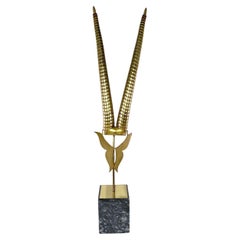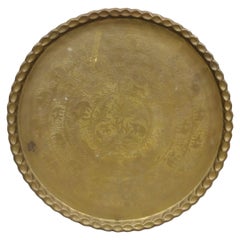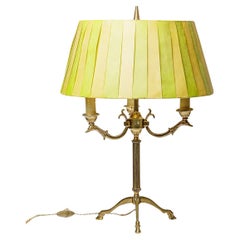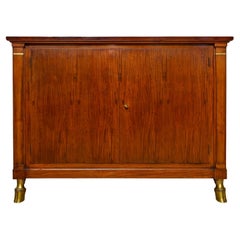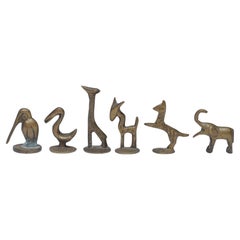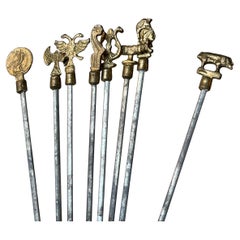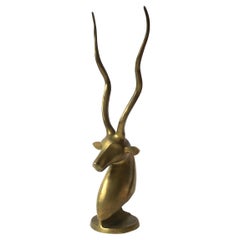Vintage Brass Animals
20th Century American Mid-Century Modern Vintage Brass Animals
Brass
1950s Austrian Mid-Century Modern Vintage Brass Animals
Brass
Mid-20th Century Unknown Other Vintage Brass Animals
Brass
Late 20th Century French Mid-Century Modern Vintage Brass Animals
Brass
Mid-20th Century French Mid-Century Modern Vintage Brass Animals
Mahogany
1950s Austrian Mid-Century Modern Vintage Brass Animals
Brass
1970s Turkish Mid-Century Modern Vintage Brass Animals
Brass, Stainless Steel
1970s Modern Vintage Brass Animals
Brass
Late 20th Century American Art Deco Vintage Brass Animals
Brass
1970s Indian Mid-Century Modern Vintage Brass Animals
Brass
1970s American Hollywood Regency Vintage Brass Animals
Brass
Mid-20th Century Indian Vintage Brass Animals
Brass
1940s American Vintage Brass Animals
Brass
Mid-20th Century Mexican Folk Art Vintage Brass Animals
Brass, Copper
Late 20th Century American Organic Modern Vintage Brass Animals
Brass
1970s American Mid-Century Modern Vintage Brass Animals
Brass
Mid-20th Century American Mid-Century Modern Vintage Brass Animals
Brass
20th Century Vintage Brass Animals
Brass
20th Century Vintage Brass Animals
Brass
1970s French Mid-Century Modern Vintage Brass Animals
Brass
Late 20th Century Vintage Brass Animals
Brass
20th Century Korean Hollywood Regency Vintage Brass Animals
Brass
1970s French Mid-Century Modern Vintage Brass Animals
Brass
20th Century Mid-Century Modern Vintage Brass Animals
Metal, Brass
20th Century Korean Hollywood Regency Vintage Brass Animals
Brass
Late 20th Century Indian Vintage Brass Animals
Brass
Mid-20th Century Portuguese Mid-Century Modern Vintage Brass Animals
Brass
1970s American Vintage Brass Animals
Brass
20th Century Japanese Vintage Brass Animals
Brass
1960s Hollywood Regency Vintage Brass Animals
Brass
Mid-20th Century Mid-Century Modern Vintage Brass Animals
Brass
20th Century Hollywood Regency Vintage Brass Animals
Brass
Mid-20th Century Korean Bohemian Vintage Brass Animals
Brass
Late 20th Century Hollywood Regency Vintage Brass Animals
Brass
Late 20th Century Vintage Brass Animals
Brass
1970s Korean Hollywood Regency Vintage Brass Animals
Brass
Mid-20th Century Philippine Mid-Century Modern Vintage Brass Animals
Brass
1970s European Hollywood Regency Vintage Brass Animals
Brass
Late 20th Century American Bohemian Vintage Brass Animals
Brass
Mid-20th Century Korean Hollywood Regency Vintage Brass Animals
Brass
1970s Korean Hollywood Regency Vintage Brass Animals
Brass
20th Century Vintage Brass Animals
Brass
1960s Hollywood Regency Vintage Brass Animals
Brass
1960s Unknown Hollywood Regency Vintage Brass Animals
Brass
Mid-20th Century Korean Hollywood Regency Vintage Brass Animals
Brass
1950s Mid-Century Modern Vintage Brass Animals
Brass
1950s Indian Anglo-Indian Vintage Brass Animals
Brass
1970s Thai Hollywood Regency Vintage Brass Animals
Brass
1960s Indian Anglo-Indian Vintage Brass Animals
Brass
1950s Unknown Mid-Century Modern Vintage Brass Animals
Brass
1950s Italian Vintage Brass Animals
Brass
1960s Unknown Hollywood Regency Vintage Brass Animals
Brass
Mid-20th Century Korean Hollywood Regency Vintage Brass Animals
Brass
1970s French Mid-Century Modern Vintage Brass Animals
Brass
20th Century American Vintage Brass Animals
Brass
20th Century Japanese Mid-Century Modern Vintage Brass Animals
Cast Stone, Brass
20th Century Mid-Century Modern Vintage Brass Animals
Brass
1970s Korean Hollywood Regency Vintage Brass Animals
Brass
- 1
- ...
Vintage Brass Animals For Sale on 1stDibs
How Much are Vintage Brass Animals?
Finding the Right Decorative-objects for You
Every time you move into a house or an apartment — or endeavor to refresh the home you’ve lived in for years — life for that space begins anew. The right home accent, be it the simple placement of a decorative bowl on a shelf or a ceramic vase for fresh flowers, can transform an area from drab to spectacular. But with so many materials and items to choose from, it’s easy to get lost in the process. The key to styling with antique and vintage decorative objects is to work toward making a happy home that best reflects your personal style.
Ceramics are a versatile addition to any home. If you’ve amassed an assortment of functional pottery over the years, think of your mugs and salad bowls as decorative objects, ideal for displaying in a glass cabinet. Vintage ceramic serveware can pop along white open shelving in your dining area, while large stoneware pitchers paired with woven baskets or quilts in an open cupboard can introduce a rustic farmhouse-style element to your den.
Translucent decorative boxes or bowls made of an acrylic plastic called Lucite — a game changer in furniture that’s easy to clean and lasts long — are modern accents that are neutral enough to dress up a coffee table or desktop without cluttering it. If you’re showcasing pieces from the past, a vintage jewelry box for displaying your treasures can spark conversation: Where is the jewelry box from? Is there a story behind it?
Abstract sculptures or an antique vessel for your home library can draw attention to your book collection and add narrative charm to the most appropriate of corners. There’s more than one way to style your bookcases, and decorative objects add a provocative dynamic. “I love magnifying glasses,” says Alex Assouline, global vice president of luxury publisher Assouline, of adding one’s cherished objects to a home library. “They are both useful and decorative. Objects really elevate libraries and can also make them more personal.”
To help with personalizing your space and truly making it your own, find an extraordinary collection of decorative objects on 1stDibs.
- Is vintage brass worth anything?1 Answer1stDibs ExpertOctober 24, 2024Yes, some vintage brass may be worth something. However, selling prices for pieces vary greatly. The maker and type of brassware are two key factors when assessing the potential value. For example, there is a market for mid-century modern brass lighting fixtures produced by Hans-Agne Jakobsson. The condition of your piece will also have an impact on how much it is worth. To get an expert opinion, consult a certified appraiser or knowledgeable antique dealer. On 1stDibs, shop an assortment of brass lighting, furniture and decorative objects.
- 1stDibs ExpertNovember 20, 2024To tell if a brass lamp is vintage, you'll need to determine if it is 20 to 99 years old by conducting online research or having an expert, such as a certified appraiser or experienced antique dealer, evaluate it. If you prefer to do the research yourself, first look for the maker's markings. Then, consult trusted online resources to identify the maker and read further to find out when the company was active and manufacturing similar lamps. Checking the plug can also be helpful. If it has two prongs of the same size, you can conclude that your lamp was made in 1962 or before, as U.S. standards set that year required all lamps to feature polarized plugs with one large and one small prong. Keep in mind that it is possible to rewire a lamp, and some makers switched to polarized plugs before the standard was established, so the lack of a non-polarized plug doesn't necessarily mean a lamp isn't pre-1962. Find a large selection of vintage brass table lamps on 1stDibs.
Read More
Kazuyo Sejima’s Flowering Tree Blooms Year-Round
The brilliantly simple design turns a modest bouquet into a major statement.
He Wrote ‘Oedipus Rex,’ but Do You Know What He Looked Like?
The Greek tragedian is said to have been handsome in his day.
Cigar Culture Was Once the Peak of Masculinity. Now, It’s a Compelling Curiosity
Even for those who don’t indulge, elegant smoking accessories and audacious art portraying cigar enthusiasts hold a nostalgic allure.
African Travel Plans on Hold? This Ardmore Leopard Vase Brings the Beauty of the Savanna to You
It’s an excellent example of the sought-after ceramics coming out of South Africa’s KwaZulu-Natal province.
With a High-Tech Flagship and Cool Collabs, Lladró Is Breaking the Mold for Porcelain Production
Thanks to its new leadership, the Spanish maker of figurines, busts and lighting is on a mission to update the art of porcelain for the 21st century.
Zoë Powell’s Magnolia 05 Vessel Is Handmade from Clay She Unearthed Herself
The free-form stoneware piece is inspired by the magnolia tree and its associations with home.
8 Ways to Breathe New Life into a Space with Plants
The pair behind the Instagram account @houseplantclub share their tips for making any room of the house gloriously green.
Paris Gallerist Sandy Toupenet Gets Fired Up over 20th-Century Ceramics and Inventive New Makers
Her space on the city’s Left Bank mixes mid-century pieces by the likes of Jean Cocteau and Pablo Picasso with whimsical contemporary creations.
